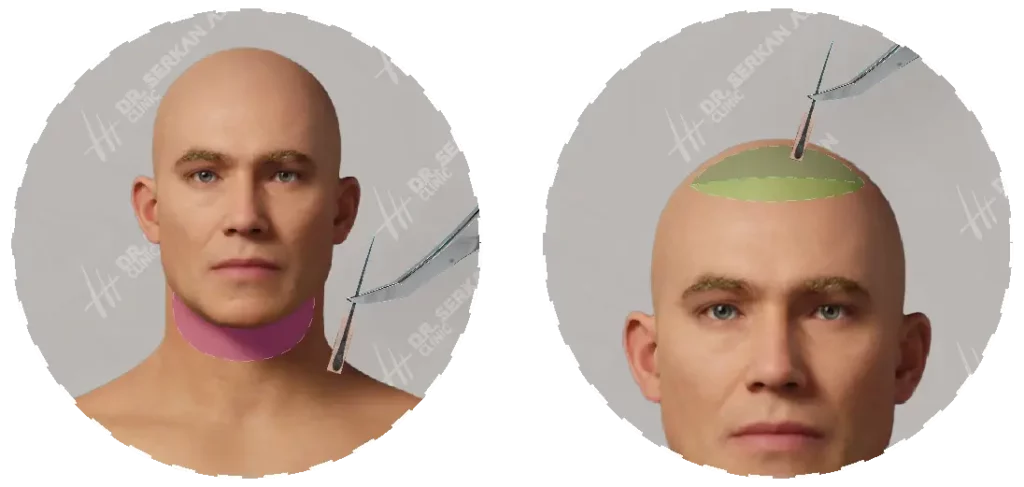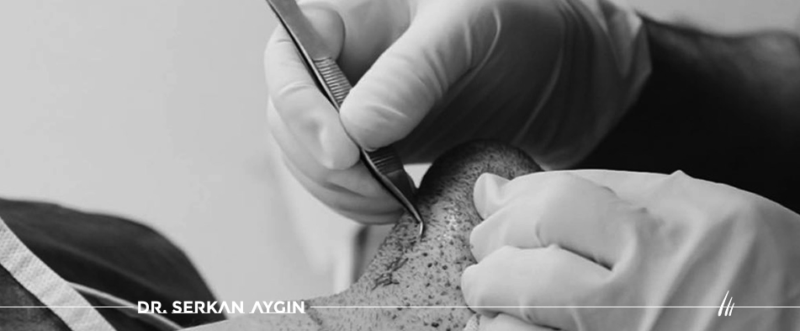Hair transplantation is an effective and permanent treatment that comprises the implantation of hair follicles grafted from an area in the body with high hair density to another area suffering from hair loss. Generally, back of the head unaffected by age-related hair loss is used as a donor area for hair restoration.
The donor density and how many grafts can be harvested from the donor area vary according various individual factors such as hair follicles density, age, etc. Besides the hair follicles taken from the donor area in the back of the head, hair follicles can also be harvested from other parts of the body; such as the beard. Beard hair is regarded as an alternative donor site to reach the required density for hair transplant surgery performed as a certain solution for hair loss.
Can You Transplant Beard Hair to Your Head?

In case of severe hair loss in men, beard to scalp hair transplant is frequently preferred method to increase the overall hair density and to cover balding spots.
In the process of hair transplant treatment from beard, strong and thick beard grafts are obtained with the help of manual micro-punch or micro-motor punch, and these grafts are transplanted to the areas where hair density is lower. At Dr. Serkan Aygın Clinic, beard to head hair transplant treatments are carried out with the DHI technique.
Is It Possible to Perform a Hair Transplant Only with Beard Hair?
Although beard hair continues to grow when implanted in the scalp of a person, it is slightly different from hair follicles in terms of its structure. Parallel to this, hair transplantation from only beard results in an unnatural image and therefore, it is not preferred to perform ahair transplant only with beard hair in general.
Beard grafts should be implanted in areas where a patient still has some hair, and it should only be used to increase the hair density of that area. In other words, beard hair follicles shouldn’t be used to cover a balding area completely. Especially in the central parts of the scalp and typically in areas where hair shedding occurs, beard to scalp hair transplant is effective to increase general density. On the other hand, scalp hair grafts should be preferred for areas experiencing an intense hair loss, such as the frontal hairline or the crown area.
How Is Beard to Scalp Hair Transplant Performed?
Hair transplantation from the beard is a procedure that does not leave any scars and is applied with the DHI technique in a short time. Beard hairs of patient in donor areas are chosen with the most appropriate density, and those beard hairs separated from the skin are implanted on the patient’s head.
Where is the Donor Area in Hair Transplant from Beard to Head?
In hair transplantation from the beard; lower jaw area, above cheekbones and neck are used as donor areas to obtain hair grafts, whereas other areas such as legs, chest hair, nape, and under the chin may also be used as a donor area. Hair grafts obtained from the beard generally contain one hair follicle, but sometimes, they could include two hair follicles as well.
Who is Eligible for Beard to Hair Transplant Turkey?
Hair transplantation is an ideal treatment for those who experience hereditary-pattern baldness or those who lose their hair due to diseases and environmental factors (burning, etc.).
Beside of this, anyone in good general health and is over 24 years old is a suitable candidate for beard to head transplantation. During the hair implantation process, donor area and whether the number of grafts adequecy are critical factors for successful hair transplant results. In cases where the donor area in the scalp is inadequate, additional donors such as hair transplant from the beard are required.
Why is Beard Hair an Alternative in Hair Transplant?
Beard is one of the best donor areas that can contribute to the results of a good hair transplant. Thickness of each beard follicle is typically approximately twice of the scalp donor hair, and thus, it increases hair volume. Besides this, extraction of beard hair from the surrounding tissues is easy.
Beard hair growth cycle resembles the growth cycle of the scalp hair. The similarity of anagen, telogen and catogen cycles of beard hair means that hair loss follows a similar period.
Even though they are a few, beard hair can replace the scalp hair due to their densitiy. For instance; 1000 beard follicles covers the same area that could be covered by approximately 2000 hairs. Consequently, more efficient results are obtained after transplantation.
Facial hairs enters the resting phase for a shorter time than in other parts of the body by staying in the growth phase for a longer period of time. This allows the hair to have an increased follicle and grow in a healthy way.
What are the Advantages of Hair Transplant from the Beard?
- It is suitable for restoring hair density. Beard hair can have a big impact on especially thin hair.
- No special care ( shampoo, etc.) is required in the beard area on the contrary of the hair. Washing with clean water is enough for that.
- The strong beard hair can negatively impact the natural looks of the front hairline if implanted in that region. Therefore, it is more preferable to apply it to other regions.
- Strong beard hairs are more resistant to hair loss.
- Thanks to the grafts taken from individuals who have dense beard structure, beard care becomes easier.
- Beard follicles are stronger than ones taken from some points of the hair scalp.
- Beard follicles stay longer in growth phases (anagen) and pass less into the resting phase (catagen). Therefore, it gives a more long-lasting result.
What to Expect from Beard to Scalp Hair Transplant?
Beard graft can be taken from face and neck before a patient experiences thinning in his beard. In cases where men do not prefer to grow a beard, the number of grafts is higher.
Beard hairs serve as a significant additional donor source for hairy patients with diffuse alopecia (ringworm) and occipital hair deficiency to support hair transplantation. Studies confirmed that use of beard hair is a safe and effective treatment to improve the cosmetic result of traditional hair transplantation in East Asian men with severe alopecia.
Healing Process After Hair Transplantation From The Beard
Beard donor area provides a faster healing compared to other regions after hair transplantation. The reason for that is the implantation of hair follicles under the skin. The depth of beard hair is 2 mm, whereas this length for scalp hair 3-4 mm. Consequently, the ease of operation applied in the region brings less damage and faster healing.
Individuals with more white skin can experience some redness after hair transplantation in the beard area. However in total, hair transplantatscar disappears within 1 week- 10 days. Beard hairs are stronger than the head hair on the top of the head, and the possibility of hair loss is less after hair transplantation.
What Are The Consequences of Hair Transplantation From The Beard?
Most patients who come to Dr Serkan Aygin Clinic with different stages of baldness have sufficient donor hair. However, some of the individuals who face severe baldness and individuals with low-quality scalp donors may need more help. At that point, beard hair is known as the best hair source after the scalp in male patients.
Even any minor intervention in medicine is likely to leave a scar. It is important that these scars disappear and that the patients feel comfortable about the beard in hair transplantation process. Consequently, operations have to be done with great efficiency, and from all points, natural images should be obtained. Removal of grafts from the beard homogeneously will prevent any visible scars. While scars that are mentioned are less common in men with stubble, they can be visible more clearly in men with black or dark skin. In these cases, situation can be controlled by collecting very few grafts.
What is the Beard to Head Hair Transplant Cost?
Hair transplant cost is generally determined in accordance with the number of grafts a patient needs. Consequently, conditions as the extent of hair loss, preferred hair transplant technique and the number of graft have a say in the price.

